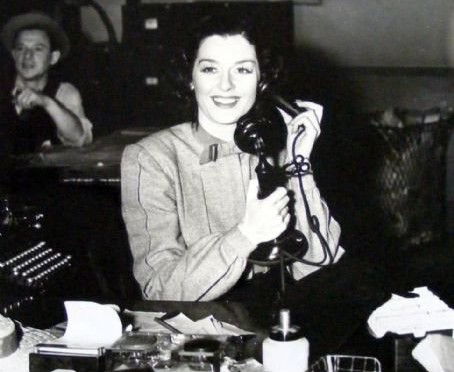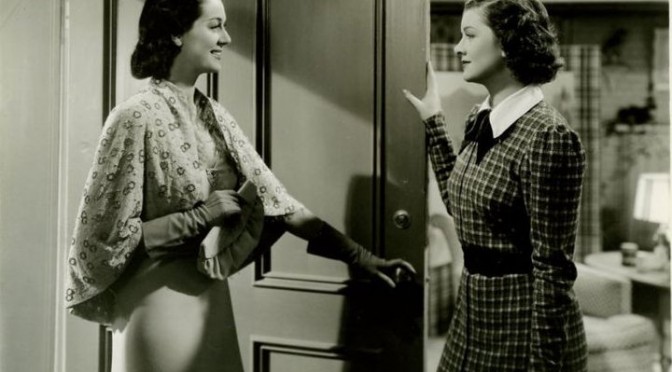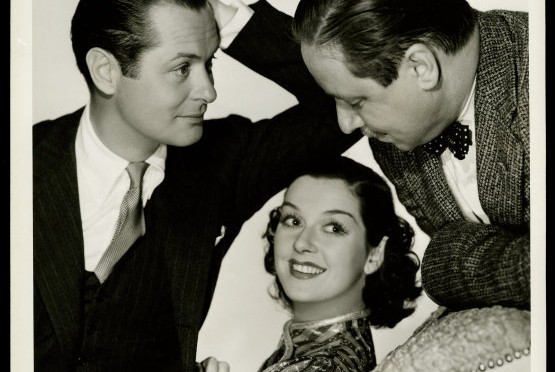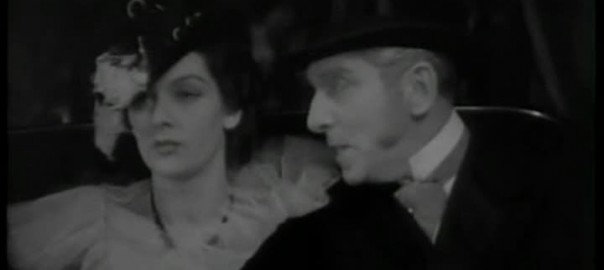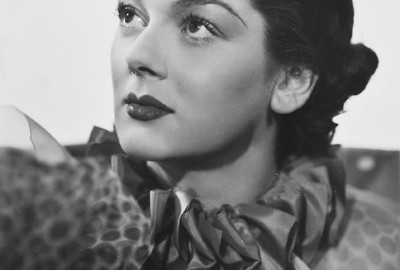
Errol Flynn and Olivia de Havilland became a popular, bankable screen couple starting in 1935 with the film Captain Blood and Warner Bros. wanted to continue that trend with the 1938 comedy Four’s a Crowd. However, it is not so much Errol Flynn and Olivia de Havilland who stand out. It is Rosalind Russell, playing an energetic, fast-talking ace reporter, much like her Hildy Johnson of His Girl Friday (1940). It is obvious from her turn as a reporter in this film that she was perfect for this type of role. A few years ago, I read a double biography of the de Havilland sisters, Olivia and her sister, Joan Fontaine. Something that has always stuck out in my memory was the fact that when Olivia, a mere 21 years old when they started filming Four’s a Crowd, was actually jealous of Rosalind Russell because of her impeccable timing, which—and I will not lie—made me smile. After all, Olivia was the star, wasn’t she? And yet she was envious of the skills of the supporting actress. And oh, she had reason to be –Roz completely stole the show from them all. She belonged in comedy, making people laugh, and it’s great to watch her in her first chance at screwball comedy.

The film opens with Miss Rosalind Russell as Jean Christy strolling happily into the newspaper offices where she works. She has a great scoop and is eager to start writing it on her typewriter. In the meantime, the reporter sitting next to her tries to tell her that the newspaper is going under and they will all probably lose their jobs. Not really listening to him, she keeps inserting insulting quips now and then: “Now listen, double ugly, please!” She finally wakes up out of her reverie and goes straight into the publisher’s office, a man she has never met. She finds Pat Buckley (Patric Knowles), the young publisher, who meets her without his pants on. Interesting meeting, to say the least. She tries to help him put his pants on, which makes him uncomfortable, but all she cares about is seeing that the newspaper doesn’t go under. She suggests rehiring Bob Lansford (Errol Flynn) as the managing editor because he is tops in the publicity department and getting the newspaper on top again. Pat has a personal problem with Bob because he is always trying to tell him what to do in his romantic relationships. Jean knows all about it and he says to her, “You know everything, don’t you?” She replies, “Well, that’s what you pay me for!” His girlfriend calls up. Her name is Lorri Dillingwell (Olivia de Havilland) and he coos over the phone to her, which annoys Jean. She leaves matter-of-factly, spouting “Oh, Mr. Buckley, please!

You may be a social lion to your friends, but to me, you’re just an animal cracker!” She turns to his assistant, pinching his cheeks and imitating Pat, she says “Coochie coochie coo!” before getting herself out of there.
Jean treks over to Bob Lansford’s office, intending to get him to come back to work on the paper. He doesn’t notice her at all the minute she enters his office, but she finally says, “Don’t look now, but I’m still here,” which is a line that is repeated throughout the film. He looks up at her and says, “Oh, so you are.” She tells him the problem with the newspaper and he doesn’t want to come back. But when she hears him trying to talk to John P. Dillingwell (Walter Connolly) and can’t get a word in edgewise, she slyly lets it slip that Pat’s romantic partner this time around is Lorri Dillingwell, John P. Dillingwell’s granddaughter, and she pretends that she is a romantic rival. Hearing the name Dillingwell and the club they’ll be at tonight, the Jamaica Room, he immediately drags Jean out of the office.

That night, they bust in on Pat and Lorri’s table. Lorri, who is quite bored at the club, is actually very amused when Bob starts insulting her by calling her a “nitwit type.” Pat lets Bob know that he isn’t keen on Jean’s idea to bring him back to the paper and Bob knows immediately what Jean is up to. “Tricky little wench, aren’t you?” he remarks to Jean. Desperate to land the big account of making her grandfather, the rich and unpopular Dillingwell, into an angel in the public’s eyes with his public relations business, he charms Lorri on the dance floor. Before Pat knows it, Lorri is being taken home by Bob and he is now alone at the club with Jean.
In the car, Bob starts telling Lorri the story of his life. He is still not finished at 8 o’clock the next morning and Lorri responds to this with “My goodness, you’ve had a long life.” When they get to her home finally, she introduces Bob to her grandfather, who naturally hates Bob. Once he hears his name, he whistles through his fingers and a large group of bounding, barking Great Danes start rushing toward him. Chased by the dogs, he runs quickly to the gate and stands outside it, laughing at the dogs. He bites one of the dog’s tails and the poor dog whimpers loudly in pain.

Suddenly, a roaring laugh rings through the bizarre scene with the dogs and he turns around and sees Jean Christy sitting in a car, laughing at him. She happily yells, “At last I’ve seen it! Man bites dog!”
Back at the newspaper offices, Bob signs a contract to help them out. Bob, Jean, and Pat put their heads together and set out to make Dillingwell the most hated man in America through scandalizing headlines and articles. Of course, Lorri isn’t thrilled with their campaign and gives Pat a punch in the nose. Meanwhile, Bob sneaks into the Dillingwell house and convinces Dillingwell to have a race with model trains, which is Dillingwell’s hobby. If Bob wins the race, he finally gets to have a few words with Dillingwell. He agrees and at the same time, Bob also convinces Lorri that she is in love with him. The night before the big race, he sneaks into the kitchen and takes all the packets of butter out of the fridge, stuffing them into his pockets. Before the race the next morning, he rubs the butter all over Dillingwell’s track so his train will slip and slow down. After he wins the race, they have lunch and he gets a chance to talk to him. Unfortunately, Lorri has also invited Jean over and Bob is unhappy about this. Dillingwell still wants nothing to do with his services and Bob goes to discuss things with Jean.

He finds out that Jean has in fact been in love with him all these years: “I’m in love with a man whom I dislike intensely, who’d cheat me, who’d lie to me, whom I wouldn’t trust as far as I could throw the Queen Mary. I…” to which he replies, “You don’t mean, do you?” “Does the description fit? You big lug…” Suddenly, when he sees Dillingwell coming outside, he drags Jean over and kisses her in front of Dillingwell and Lorri. Right away, Jean can see through his act and knows he is up to no good. Unfortunately for him, Dillingwell has been told that it was Bob’s idea to make him the most hated man in America and once again, he calls the dogs on him. So there he goes again, running toward the front gate in just his swimming trunks.
However, in spite of everything, Dillingwell decides to use Bob’s services in order to improve his sagging reputation. He gives millions of Dillingwell’s money to a charity for infantile paralysis under an assumed name, H. Louis Brown. He will seem like a better man if he anonymously gives to charity instead of broadcasting it to everyone. What follows is one of the funniest scenes in the film – Bob, who has two women in love with him (Jean and Lorri), has both women on two different phones talking to him.

For anyone who thought Errol Flynn could only do adventure and drama, they should watch this scene. As he talks back and forth between phones, which looks like a very confusing task, it is funny how he gets each woman to believe that the other is not on the phone with him. This single scene elevates Errol to second funniest in the film (behind Roz, of course).
Back at the office, Jean and Pat have no idea who this H. Louis Brown is, so Pat sends Jean on a mission to find him. After a long search of every alternative of the name, she gets her shoes shined by a man named H. Louis Brown. He gets his photograph taken and now they know that there is a rich man giving millions of dollars behind this name. They just need to expose the man. She ventures over to Bob’s office, gently trying to get him to tell her who the man is, calling him “darling,” while he calls her “sweetheart.” As they coo pet names to each other, she roughly pulls his hair and he in turn bites her hand, causing her to squeal with pain. As soon as Bob leaves his office, Jean makes a run for his file room, going through every single file in the cabinets, searching for a clue.

With no hope left in her search, she tosses the last paper and pensively places her fist under her chin, not realizing she is looking right at a miniature statue of Rodin’s The Thinker. The face she makes as she realizes she is imitating the statue is priceless. Just when she thinks all hope is lost, the Goodwill Clinic calls up Bob’s office and she figures out that Bob will be there that evening. She runs for the clinic and pretends to be Bob’s wife in order to get inside. Eventually, she sees Lorri and her grandfather begging to be let in and she immediately knows that Dillingwell is the culprit behind “H. Louis Brown.” She has Bob over a barrel with a juicy story like this to tell her paper. She is angry when she hears Lorri mention that Bob is her fiancé and she congratulates them, not meaning it at all.

When Jean meets Pat, telling him she has the story, she reveals that she will not tell him because she is in love with Bob Lansford and Bob doesn’t want her to leak it. However, after a fainting spell following a proposal from Pat, she agrees to marry Pat, but will only tell him the story after they are married. Once Bob finds out that Pat and Jean will be married that night, he goes after them with Lorri by his side, intending to marry her.

Once they get to the justice of the peace, they all act like they don’t care about who marries who, but we all know they are marrying the wrong people. In fact, they do all they can to get the other couple to get married first. After much confusion, they end up marrying the people they love, and it is a surprise, considering who the stars of this film are—Jean to Bob and Lorri to Pat. The film ends in a very silly way when the four of them get into a car together, trying to get away from Dillingwell, who has brought cars of dogs with him to chase after them (what?!) and then Bob and Lorri kiss in the car, as if they don’t know who they just married. “Hey! That’s my wife!” Oh, boy.
A clip from the film for you to enjoy:

